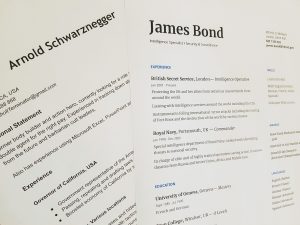Most people wonder what the difference between a CV and a resume is. Well, the answer to that query is actually quite simple; there’s not a very big difference.
What the British and most countries call a CV is what Americans call a resume. However, a CV will generally focus a little more on your educational background and special projects you’ve worked on.
So, how do you draft a CV that will win in the middle of over 200 CVs sent when you want that job? What can make your CV stand out? What if you only have a couple of minutes to draft a CV? Here are the best ways to do it to come up with an exceptional result.
How to Quickly Draft an Exceptional CV
Fonts Need To be Professional

The kind of fonts you use on your CV will play a huge role in determining whether you get the job. Some fonts can show how professional you are, and others can scream to the employer “hell no!” By using the likes of Times New Roman, Arial, and Tahoma, you will show your future employer that you are serious. For best results, try keeping to those three for a start.
Your CV’s Layout Needs To Be Consistent

When drafting a CV, you need to make sure that it is consistent throughout. It needs to be in uniform, from the fonts to the headings to the inch margins. Failure to be consistent can be detrimental to your getting that job, as it shows that you may be lazy or not careful to attention.
Minimise The Graphics On Your CV

The fewer graphic is on your CV, the better. With graphics crammed up in your CV, you will come across as more unprofessional and immature. Your experience should speak for itself; you shouldn’t need fancy images to do the work for you. On your CV, white space is your friend.
Relevance and Brevity Works Like Magic

When jobs are posted in this market today, there are many applications that will come through. To help you stay ahead of the competition, make sure your CV is brief. You don’t want to include every little detail of your life in your CV. No one cares where you went to school before college. That can be addressed in the interview.
Draft a CV with your: Name, Title, Email, LinkedIn profile (if you don’t have one, get one ASAP). Also, be sure that employers will research your LinkedIn profile, so it’s best to make your CV match the profile you send to them. Also, make sure you summarise your CV with your progress and achievement.
Remove Photos From Your CV

Most HRs are turned off by personal photos on CVs. Let me clear this up, unless your future employer explicitly asks for your photo on the CV, don’t put it there. Take a professional photo if that’s what’s needed, and a passport size one will do just great.
Consciously Hit The Points

You want your future employer to know exactly what you’ll do for him/her. You don’t want to be beating around the bush on your CV. For example, if you’re applying for an organization named Cephro Hospital, make sure you address how you’ll be of benefit to Cephro Hospital. Also, underline what your role will be there and help them know you can solve their problems.
Conclusion
When drafting a CV, several people go wrong because they try overdoing it. A simple CV will almost always ensure you get to the interview, if not the job. You don’t need to put hours into putting together an exceptional CV. Use the steps above, and you’ll be good to go.






